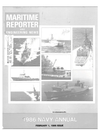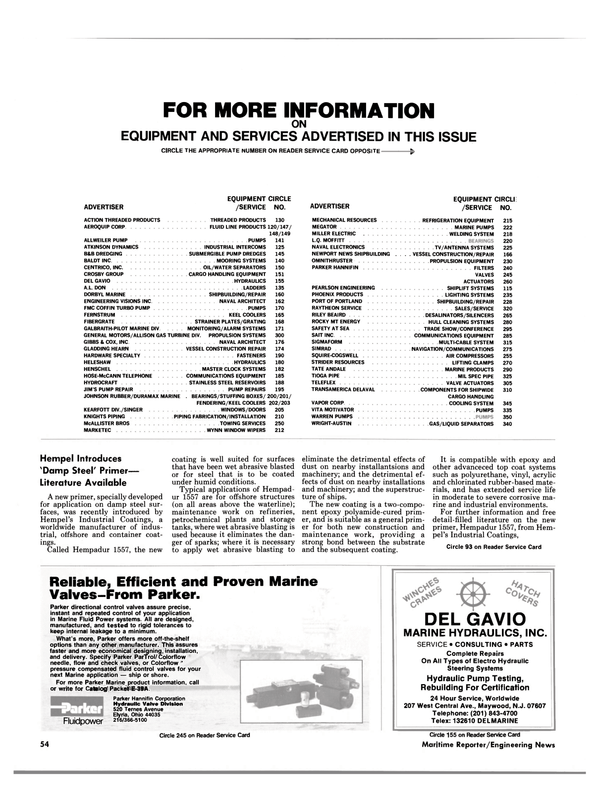
New Teleflex Remote Valve Actuators Are Designed To Eliminate Problems And Cut Costs
—Literature Available System failures due to corrosion, misalignment and binding are problems that have plagued the current methods of remote valve actuation for years. The use of these methods will decrease with the development of the Remote Mechanical Valve Actuator (RMVA) by Teleflex Inc.'s Remote Actuation System Group.
Teleflex reports their RMVA system was designed to eliminate the problems associated with these conventional methods. It has been approved for use on all U.S. Naval surface vessels and is certified by the American Bureau of Shipping. In fact, the RMVA system has been in use aboard U.S. Naval vessels for over two years, and has proved itself to be more reliable and cost effective.
RMVA System Design RMVA has been designed with a minimum number of parts, all of which are enclosed in a sealed system for increased reliability. It operates using a tension-tension closed loop actuating system and can replace most existing manual remote valve actuators, as well as hydraulic and pneumatic systems. At the heart of this patented system is a helical cable that Teleflex has manufactured for the aerospace and marine industry for over 40 years.
The helical cable meshes with cable gears located in the actuator housings that are at each end of the system. Each cable gear has a worm gear with a pitch matching the pitch of the helical wrap on the cable; this allows the meshing of the cable and the gear. The rotary motion from the remote operator is then transmitted through the input shaft to the cable gear in the operator station actuator housing. When this occurs the cable gear/helical cable interface converts the rotary motion to a linear movement of the cable.
The cable moves linearly in a conduit through the system driving the cable gear in the valve station actuator housing where the motion is converted back to a rotary output via an identical cable gear/helical cable interface.
The rotary motion is transmitted through the output shaft to the valve coupling. The helical cable is protected from the environment by a conduit that is both flexible and durable.
While the remote operator stations and the valve couplings are similar to those available with the reach rod and flexible shafting system, the Teleflex components have been manufactured using materials that offer superior corrosion resistance.
The system is available with either handwheel driven remote operators or deck boxes; rising stem, nonrising stem and rising handwheel valve couplings can be supplied with or without quick disconnects. Cus- torn designed valve couplings are also available to meet specific application requirements.
Cost Savings In addition to providing increased reliability, RMVA yields significant cost savings when compared to reach rod and flexible shafting applications.
"The flexibility of the RMVA conduit allows the system to make bends without the use of expensive gear boxes," said Larry Resnick, Teleflex sales engineering manager. "The conduit's flexibility also eliminates the need for troublesome, costly universal joints by allowing the system to be routed without worrying about critical alignments." Also, since the system is permanently lubricated during assembly, regular maintenance is not required.
Easy Installation Perhaps the most significant cost savings that can be attributed to the RMVA system is the ease of installation.
Recent studies have shown that installation costs can be reduced by as much as 65 percent versus comparable reach rod and flexible shafting applications. In fact, one major shipyard has estimated that replacing just 59 reach rod and flexible shafting systems with the RMVA will save approximately 4,000 man-hours per ship. This savings is due to the flexibility of the conduit. This simplifies the routing of the system since no gear boxes or universal joints are required to change directions. Also, the RMVA eliminates the need for shop preparation.
"Given today's labor rates, this corresponds to a significant savings in labor dollars," Mr. Resnick added.
"Time is also saved when ordering the RMVA since it is supplied as a complete system—there is no need to spend time identifying and ordering individual components." The system also includes all hardware required for installation.
Weight Reduction RMVA eliminates gear boxes, universal joints, heavy shaft hangers and the rod and shafting themselves to yield significant reductions in system weight. The shipyard noted above found that the same 59 applications resulted in a weight savings of 1.14 long tons per ship (2,561 pounds).
"The Teleflex RMVA has been designed to survive in the harshest environments," Mr. Resnick said.
"The fact that the RMVA has been used on naval ships over the past two years and still has not had a system failure is evidence of its superior reliability." The increased reliability, the elimination of regular maintenance and the significant cost savings indicate that the RMVA is a viable replacement for the troublesome remote actuation systems currently in use.
For further information, including detailed literature on Teleflex's remote mechanical valve actuator, Circle 8 on Reader Service Card
Read New Teleflex Remote Valve Actuators Are Designed To Eliminate Problems And Cut Costs in Pdf, Flash or Html5 edition of February 1986 Maritime Reporter
Other stories from February 1986 issue
Content
- Bremer Vulkan To Build 2 Bremen Class Frigates For Federal German Navy page: 5
- Study To Evaluate Tanker-Based FPSO For Gulf Of Mexico page: 5
- Marinette Marine Delivers Last Of 52 Workboats A Year Ahead Of Schedule page: 6
- Boston Fuel Acquire Assets Of Boston Towboat Co. page: 7
- M.A.N.-GHH To Build Floating Drydock For Polish Shipyard page: 7
- British Broker Reports Surge In Tanker Rates, Fall In Laid-Up Tonnage page: 7
- Robert E. Derecktor Launches First Of Two Staten Island Ferries page: 8
- Beth-Sparrows Point Yard Installs $1.1-Million Intermediate Gate For Building/Vessel Servicing Basin page: 8
- New Names Announced For Wartsila Diesel Units page: 9
- HIAB-FOCO Delivers Two Service Cranes To North Sea Oil Project page: 9
- Bath Iron Works Launches Its First Aegis Cruiser page: 10
- Water Jetting System To Install Steel Pilings Developed By Navy page: 11
- USCG And ASNE Flagship Section Sponsor Patrol Boat Symposium page: 12
- Webber Appointed Vice Admiral And U.S. Navy's Chief Engineer page: 12
- Automatic Power Offers 20-Page Color Brochure On Marine Signal Systems page: 12
- Captain Hjelde Named VP And GM At Barber page: 13
- TeleSystems MCS-9100 Receives Japanese Type Acceptance page: 13
- IS IT TIME TO TAKE THE PUBLIC SHIPYARDS PRIVATE? page: 16
- UPDATE ON FY 1986 NAVY PROGRAMS page: 26
- Navy Contracts Totaling $629.2 Million Awarded To Bath And Ingalls Yards page: 30
- Peterson Builders Delivers ARS-51, Grasp, To Navy page: 31
- 1986 Apelco Full-Color Product Catalog Available page: 34
- Carnegie Hero Medals Awarded Posthumously To Fournier, Govoni page: 34
- Coast Guard And Navy To Hold Joint Fire Research Program page: 35
- Peterson Builders Receives Navy Certification Of Metal Spray Facility page: 35
- Key Appointments At Oerlikon page: 36
- NICOR Consolidates Administrative Functions Of 2 Marine Subsidiaries page: 36
- BP Offers Free 32-Page Brochure On World Energy page: 37
- ASEA Names Jon Turley Manager Marine Offshore page: 37
- New One-Stop Shopping Sensors And Controls Catalog From Transamerica Delaval page: 38
- Marine Machinery Association To Sponsor Navy/Industry Panel Discussions On Feb. 26 page: 38
- The New 710G Series Diesel Engines From General Motors Electro-Motive Division page: 40
- Todd Ceases Operations At New Orleans Division page: 41
- Marine Travelift Introduces New Floating Boat Hoist Design page: 41
- Puroflow Filters To Protect Sperry Computers page: 42
- Texas Instruments Offers New GPS Software page: 43
- Aegis Missle Cruiser Valley Forge Commissioned At Ingalls Yard page: 44
- New Yard Opens In Port of Altamira page: 47
- Jacques Cousteau Receives Testimonial Plaque From Carrier Transicold Employees page: 47
- Vecom Takes Over Marine Division Of Houseman page: 48
- Caterpillar Offers Literature On New Marine Diesel Propulsion System Products And Support Programs page: 49
- New Teleflex Remote Valve Actuators Are Designed To Eliminate Problems And Cut Costs page: 52
- Dr. A.C. Antoniou Joins ASRY Production Team page: 53
- Dillingham Offers Free Full-Color Brochure On Ship Repair Facilities page: 53
- Hempel Introduces 'Damp Steel' Primer page: 54
- Reco Crane Promotes Hardin—Literature Offered page: 60
- Metropolitan Offers New Vanstone Flanged Fittings page: 60
- Meyer Retires As Deputy Commander At NAVSEA page: 60
- American Appoints Monaco New Cordage Engineer page: 61


